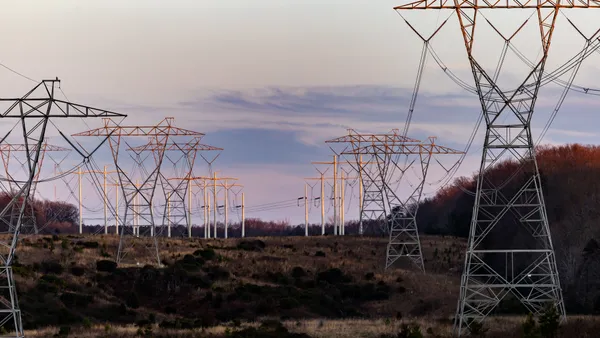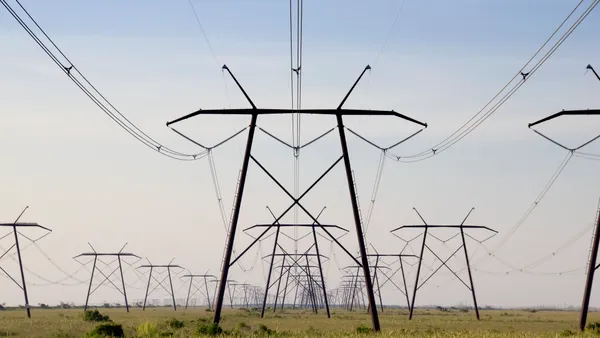Dive Brief:
-
The New Jersey Bureau of Public Utilities on Wednesday approved a set of “transmission-first” projects to connect 6.4 GW of potential offshore wind to the grid after sorting through 80 proposals made by 13 companies.
-
The BPU selected a $505 million proposal brought by Jersey Central Power & Light, a FirstEnergy utility, and Mid-Atlantic Offshore Development, a joint venture between Shell New Energies US and EDF Renewables North America, that will provide wind farms a shared connection point to the mainland. The BPU tapped other utilities and transmission companies to build about $575 million in other onshore upgrades.
-
“This action reflects a milestone in development of proactive ‘transmission first’ infrastructure development in the offshore space,” Rob Gramlich, president of Grid Strategies, said, noting the approach has been used successfully in West Texas, the Upper and Lower Great Plains, and parts of the Northwest and California.
Dive Insight:
While regions like New England are starting to consider a holistic approach to transmission development for offshore wind, New Jersey’s BPU approved a plan that will give multiple wind farms a pathway onto the state’s grid.
“The board finds that this ‘transmission-first’ approach to offshore wind, undertaken in partnership with its regional grid operator, PJM Interconnection …, will lower costs, reduce the chance of delays in offshore wind projects and minimize community and environmental impacts,” the BPU said in the decision.
The plan will save at least $900 million compared with each wind farm building their own transmission, Andrea Hart, the agency’s senior offshore wind program manager, said Wednesday during an agency meeting. The plan will cost the average residential customer $1.03 a month, according to the BPU.
The approved interconnection project, called the Larrabee Tri-Collector, was designed to take advantage of federal tax incentives that could be worth about $2.2 billion, according to Hart.
The BPU considered proposals for an offshore transmission “backbone” running in the ocean parallel to the state’s coast, but found its costs outweighed the benefits, Hart said. Backbone projects would connect offshore substations to each other to directly interconnect multiple offshore wind projects, according to the BPU.
The project and related grid upgrades will allow New Jersey to seek direct federal funding for future expansions of the offshore wind transmission system, including potential funding for a full offshore wind backbone, according to the agency.
The approved transmission plan could change if circumstances shift, Hart said.
The companies selected to build various upgrades to support the introduction of offshore wind onto the grid include JCP&L, Public Service Electric and Gas, LS Power, PPL, Transource Energy, and Exelon’s Atlantic City Electric, Baltimore Gas and Electric and Potomac Electric.
New Jersey has been considering developing a coordinated transmission solution for offshore wind since 2019. In 2020, New Jersey became the first state to take advantage of the PJM’s “state agreement approach,” or SAA, which allows a state to propose and pay for transmission upgrades it needs to meet its energy goals.
New Jersey aims to play a major role in the U.S. offshore wind sector, with Gov. Phil Murphy, a Democrat, last month increasing the state’s offshore wind goal to 11 GW by 2040 from 7.5 GW by 2035.
“It is certainly an historic event in the progression of offshore wind,” BPU President Joseph Fiordaliso said during the agency’s meeting. “Today's action ensures that we are meeting the state's offshore goals in the most efficient, responsible, cost effective manner possible … and we’re not finished.”
The BPU directed its staff to take initial steps to pursue a second SAA process to plan additional transmission to help reach the state’s 11-GW offshore goal.
“It may be beneficial, prior to initiation of the second SAA, to review with other states, both inside and outside the PJM region, the potential for jointly undertaking an offshore wind planning process and incorporating those larger needs, into this future SAA,” agency staff said in the BPU’s decision.
Working with other states on a coordinated transmission buildout could be complex, but would likely reduce ratepayer costs by identifying regional solutions and through cost-sharing with other states, staff said.
The transmission decision could affect two offshore projects that won contracts with the BPU last year. They are Ørsted’s 1,148-MW Ocean Wind 2 project and a 1,510-MW project from Atlantic Shores Offshore Wind, a Shell New Energies and EDF Renewables joint venture.
“The NJBPU proceeding highlights the considerable level of investment and complexity related to the associated infrastructure that could be required to integrate the output from large offshore wind projects into a regional power grid,” Paul Patterson, a Glenrock Associates equity analyst, said in an email Wednesday.















